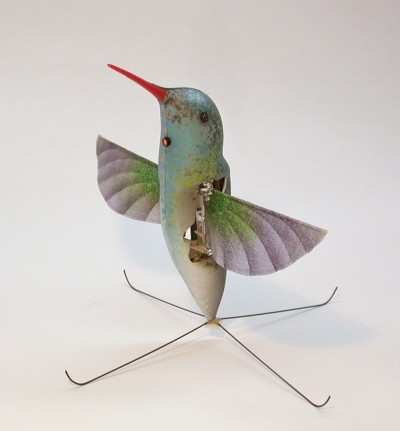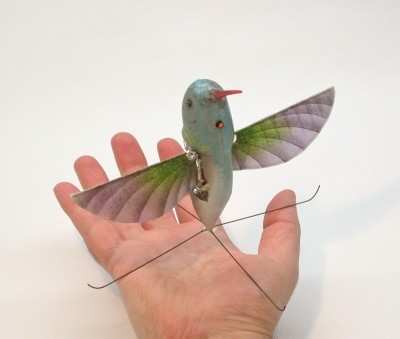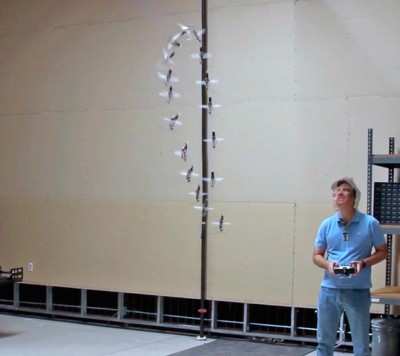Tiny Aircraft Hovers and Flies in Any Direction, Weighs
Two-Thirds Of An Ounce Including Batteries And Video Camera
In a technical milestone never before achieved, AeroVironment
says it has demonstrated controlled precision hovering and
fast-forward flight of a two-wing, flapping wing aircraft that
carries its own energy source, and uses only the flapping wings for
propulsion and control.

The milestone was part of the Phase II contract awarded by the
Defense Advanced Research Projects Agency (DARPA) to AV to design
and build a flying prototype "hummingbird-like" aircraft for the
Nano Air Vehicle (NAV) program. "The success of the NAV program
paves the way for a new generation of aircraft with the agility and
appearance of small birds," said DARPA NAV program manager, Dr.
Todd Hylton, in announcing the accomplishment Wednesday.
The final concept demonstrator is called the 'Nano Hummingbird'
and is capable of climbing and descending vertically, flying
sideways left and right, flying forward and backward, as well as
rotating clockwise and counter-clockwise, under remote control and
carrying a video camera payload. During the demonstration the Nano
Hummingbird flew in and out of a building through a normal-size
doorway. "The historic achievement made by the Nano Hummingbird is
an example of the leading-edge innovations introduced and deployed
almost routinely by the AeroVironment UAS team," said Tom Herring,
AV senior vice president and general manager of Unmanned Aircraft
Systems. "From the battle-proven Raven, Wasp and Puma small UAS to
the tiny Nano Hummingbird to Global Observer, the largest, highest
and longest flying UAS, AeroVironment continues to define the
future of unmanned aircraft systems. Our mission in doing so is to
provide our customers with advanced tools that help them
succeed."

The hand-made prototype aircraft has a wingspan of 16
centimeters (6.5 inches) tip-to- tip and has a total flying weight
of 19 grams (2/3 ounce), which is less than the weight of a common
AA battery. This includes all the systems required for flight;
batteries, motors, communications systems and video camera. The
aircraft can be fitted with a removable body fairing, which is
shaped to have the appearance of a real hummingbird. The aircraft
is larger and heavier than an average hummingbird, but is smaller
and lighter than the largest hummingbird currently found in
nature.
"The success of the Nano Hummingbird was highly dependent on the
intense combination of creative, scientific, and artistic
problem-solving skills from the many AV team members, aided by a
philosophy of continuous learning, which we feel was only possible
due to the unique R&D environment here at AV," said Matt
Keennon, AV's project manager and principal investigator on the NAV
project.

The technical goals for the Phase II effort were set out by
DARPA as flight test milestones for the aircraft to achieve by the
end of the contract effort. The Nano Hummingbird met all, and
exceeded many, of the milestones:
- Demonstrate precision hover flight within a virtual
two-meter diameter sphere for one minute.
- Demonstrate hover stability in a wind gust flight which
required the aircraft to hover and tolerate a two-meter per second
(five miles per hour) wind gust from the side, without drifting
downwind more than one meter.
- Demonstrate a continuous hover endurance of eight minutes with
no external power source.
- Fly and demonstrate controlled, transition flight from hover to
11-miles-per-hour fast forward flight and back to hover
flight.
- Demonstrate flying from outdoors to indoors, and back out doors
through a normal-size doorway.
- Demonstrate flying indoors 'heads-down' where the pilot
operates the aircraft only looking at the live video image stream
from the aircraft, without looking at or hearing the aircraft
directly.
- Fly the aircraft in hover and fast forward flight with
bird-shaped body and bird-shaped wings.
 ANN's Daily Aero-Linx (04.16.24)
ANN's Daily Aero-Linx (04.16.24) Aero-News: Quote of the Day (04.16.24)
Aero-News: Quote of the Day (04.16.24) Airborne 04.10.24: SnF24!, A50 Heritage Reveal, HeliCycle!, Montaer MC-01
Airborne 04.10.24: SnF24!, A50 Heritage Reveal, HeliCycle!, Montaer MC-01 Airborne 04.12.24: SnF24!, G100UL Is Here, Holy Micro, Plane Tags
Airborne 04.12.24: SnF24!, G100UL Is Here, Holy Micro, Plane Tags Airborne-Flight Training 04.17.24: Feds Need Controllers, Spirit Delay, Redbird
Airborne-Flight Training 04.17.24: Feds Need Controllers, Spirit Delay, Redbird





